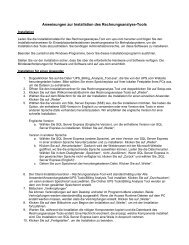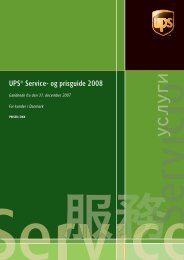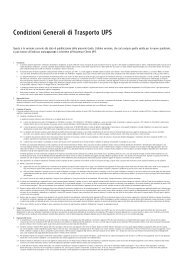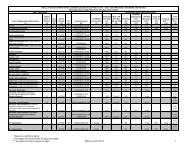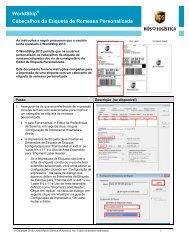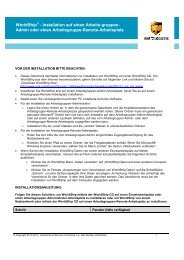2005 UPS Rate and Service Guide
2005 UPS Rate and Service Guide
2005 UPS Rate and Service Guide
Create successful ePaper yourself
Turn your PDF publications into a flip-book with our unique Google optimized e-Paper software.
20<br />
Determine Weight <strong>and</strong> Size<br />
Domestic Air <strong>and</strong> <strong>UPS</strong> 3 Day Select SM<br />
Shipments, Including Puerto Rico<br />
Dimensional Weight<br />
Dimensional weight may apply to<br />
<strong>UPS</strong> Next Day Air ® Early A.M. ® , <strong>UPS</strong><br />
Next Day Air ® , <strong>UPS</strong> Next Day Air<br />
Saver ® , <strong>UPS</strong> 2nd Day Air A.M. ® ,<br />
<strong>UPS</strong> 2nd Day Air ® <strong>and</strong> <strong>UPS</strong> 3 Day<br />
Select. Use the following steps<br />
for weight <strong>and</strong> size calculations.<br />
1. Determine actual weight.<br />
Use any st<strong>and</strong>ard scale <strong>and</strong> round<br />
up any fraction of a pound to the<br />
next full pound.<br />
2. Determine dimensional<br />
weight.<br />
Multiply the package length by<br />
the width by the height. For each<br />
measurement, round off any fraction<br />
to the nearest whole inch (for<br />
example, 1.00" to 1.49" will be<br />
considered 1 inch, <strong>and</strong> 1.50" to<br />
1.99" will be considered 2 inches).<br />
The result is the cubic size. Divide<br />
the cubic size by 194 to determine<br />
dimensional weight in pounds.<br />
Increase any fraction to the<br />
next pound.<br />
Multiple Packages<br />
If you have more than one package<br />
to be shipped, consider each package<br />
a separate shipment for weight<br />
calculation purposes. For <strong>UPS</strong><br />
Hundredweight <strong>Service</strong> ® shipments,<br />
see pages 60 <strong>and</strong> 61.<br />
Dimensional Weight =<br />
L = Length in inches<br />
W = Width in inches<br />
H = Height in inches<br />
L x W x H<br />
194<br />
3. Determine billable weight.<br />
Compare each package’s actual<br />
weight to its dimensional weight.<br />
The greater of the two weights<br />
is the billable weight <strong>and</strong> should<br />
be used to calculate the rate.<br />
4. Determine if Large Air<br />
Package rules apply to your<br />
<strong>UPS</strong> domestic shipments.<br />
Large Air Packages<br />
A package shipped using a <strong>UPS</strong><br />
Air <strong>Service</strong> or <strong>UPS</strong> 3 Day Select is<br />
considered a “Large Air Package”<br />
when its length, combined with<br />
twice the width plus twice the<br />
height, exceeds 130 inches, <strong>and</strong><br />
is equal to or less than 165 inches.<br />
Large Air Packages are subject to<br />
a minimum billable rate of $90.<br />
After calculating the rate of the<br />
package, compare the rate to the<br />
minimum billable rate, <strong>and</strong> apply<br />
the greater of the two. The minimum<br />
billable rate will not apply<br />
to <strong>UPS</strong> Hundredweight <strong>Service</strong><br />
shipments.<br />
To determine the rate for singlepackage<br />
shipments with a dimensional<br />
weight of 150 pounds or<br />
more, multiply the package weight<br />
by the price per pound multiplier,<br />
located at the end of the applicable<br />
rate chart.<br />
L W<br />
H<br />
Billable Weight:<br />
Actual or Dimensional?<br />
Determining which weight to use<br />
in calculating your rate requires<br />
that you determine which rule<br />
applies. Different rules apply<br />
depending on the service<br />
selected.<br />
Dimensional weight considers<br />
density, which is the amount<br />
of space a package occupies<br />
in relation to its actual weight,<br />
to determine billable weight.<br />
Calculations of dimensional<br />
weight are based on the<br />
International Air Transport<br />
Association (IATA) volumetric<br />
st<strong>and</strong>ards (subject to change<br />
without notice).<br />
Irregularly Shaped Packages<br />
Measure boxes or containers that<br />
are not rectangular to determine<br />
dimensional weight <strong>and</strong> whether<br />
the package is within maximum<br />
limits. Treat the irregularly shaped<br />
package as if it were in a regular<br />
rectangular box. Measure the<br />
length, width <strong>and</strong> height of the<br />
package from its extreme points.<br />
Height<br />
Length<br />
Width<br />
Note: Packages that exceed <strong>UPS</strong><br />
weight <strong>and</strong> size limits are not<br />
accepted for transportation.<br />
If found in the <strong>UPS</strong> system, they<br />
are subject to an Over Maximum<br />
Limits charge. See page 125 or<br />
126 for details. For Maximum<br />
Weight service restrictions,<br />
see page 128.





